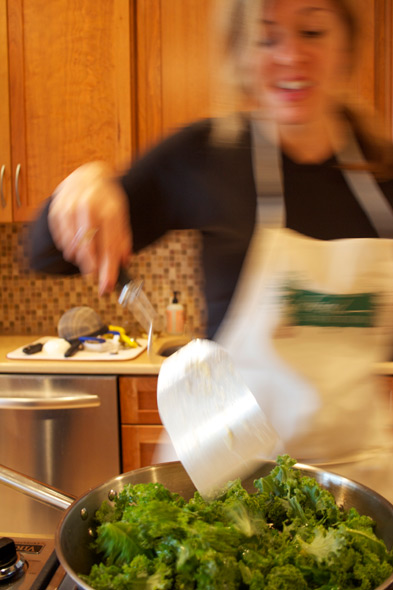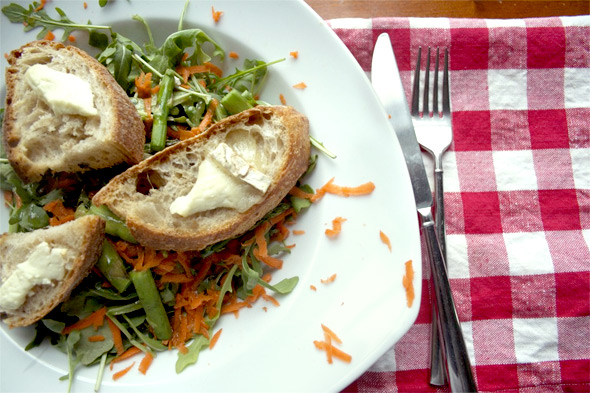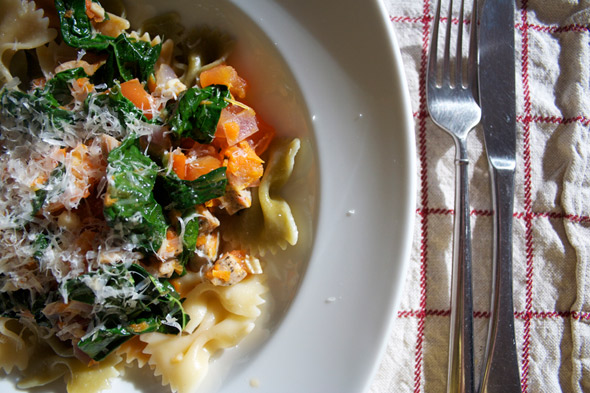Health
Fresh from the market Latino!04.09.11
You must think I’m turning all health nut on you. I realize that many of my recent entries have been focusing on healthful cooking and wholesome recipes, but that doesn’t mean I’m leaving my Latin roots behind. The truth is that this semester a Consumer Journalism class at school has opened my eyes to some of the realities of our country’s food system. Coincidentally, I’ve come across some interesting articles recently that bring fresh ideas to the Latin kitchen. One of my favorite Latin food bloggers Ana Sofía Pelaez, recently wrote about the benefits of Latin American super-grains amaranth and quinoa. Lorenza Muñoz shed some light on the vegetarian options that abound in Mexican cooking in her latest story in the LA Times. more »
Organics 2.004.02.11
These days, it seems that everywhere you turn, there’s an organic counterpart to a product you’re consuming: shampoo, vegetables, dairy, even cosmetics. Their labels usually market the product as “All Natural” and “100% Organic” and are typically more expensive. But are these products worth the higher cost and most importantly, do they deliver on their claim? Keep reading to discover what you need to know to shop organics the smart way.
It’s easy to shop organic.
FALSE.
In the past few years, manufacturers have leveraged the country’s obsession with healthier eating by producing more organic products. However, for a product to have a USDA-certified organic sticker and be certified organic, it must be composed of at least 95% organic ingredients. Consumers are easily misled by those products with the word “organic” on their label, and often end up paying more for a product that has organic ingredients, but isn’t certified organic.
Diane Hoch, nutritional health counselor and founder of Food Evolution, a nutrition and cooking center in Bardonia, New York, defines the word “organic” in simple terms: “Organic is how nature intended food to be.” When shopping for produce, she suggests looking at the PLU sticker. A number 9 in front of the 4-digit number indicates the product is organic; an 8 indicates that the product has been genetically modified (yuck!).
In shopping for poultry, she recommends you look for “Free Range Organic” on the label or labeling that says “Hormone Free, Antibiotic Free” or “raised on a vegetarian diet without the use of hormones, antibiotics, steroids”. Ideally, beef should be “Grass Fed Organic” and/or purchased directly from a farm.
Organic food means more healthful food.
DEPENDS.
Organic food is food that hasn’t’ been grown using pesticides or chemical additives. It is food that doesn’t come from GMO’s (genetically modified organisms) that have been developed inside a lab, instead of in an open field. Traditionally, food was farmed in a system of rotating crops that would attract pollinators and give the earth time to replenish itself. Contemporary industrial agriculture subsists on a monoculture focused mostly on the crops of corn and soy. Thus, farmers have had to resort to using chemicals and pesticides in order to grow their crops because the earth is literally exhausted.
Virginia Schiffino, former Associate Professor of the NYU Food Studies Program, believes that organic good doesn’t equal healthful food, since now organic versions of junk food are now readily available. “I’d’ rather buy a nonorganic brussels sprouts than an organic box of cereal,” she says.
You can be eating food that’s organic that doesn’t have organic certification.
TRUE.
When you visit your local fresh market, it’s possible to buy food that’s organic without being organically certified. There are costs involved in acquiring an organic certification, so those producers whose annual sales don’t exceed $5,000 are exempted from the certification. You can often find this produce at your local farmer’s market, or at CSA’s (Community Supported Agriculture) programs, where it’s possible to visit the farm and ask the farmer directly about the kind of growing methods that are used.
Products need to be made with 100% organic materials to be labeled organic.
FALSE.
In order to be labeled organic, a product must have at least 95% organic ingredients. If it has 70%, the product can be labeled as “made with organic ingredients”. The National Organic Program (NOP) is the federal regulatory agency governing organic food, administered by the USDA. The Organic Food Production Act of 1990 required the USDA develop national standards for organic products, which covers production, processing, delivery and sale of organic products.
When a product is not organic, you can automatically assume that it has some GMO components.
TRUE.
GMO’s are genetically modified organisms that have been altered or developed inside a lab. Food that is not certified organic has at least some traces of GMO’s. High fructose corn syrup and hydrogenated oils are examples of GMO’s that are commonly found in most of today’s processed foods. To Schiffino, what is more perplexing is that fact that when something is not organically certified, you don’t know why it’s not. “When something is certified, it’s absolutely clear, but when not, the consumer is lacking in a lot of information,” she says. There are parts of the world in which more transparency exists when it comes to what’s in your food. In Europe, for example, labeling requirements specify that manufactures have to let consumers know the ingredients that are GMO’s.
You should stay away from the “Dirty Dozen” to reduce pesticides in your diet.
TRUE.
There’s a list of produce that is more prone to absorbing pesticides because of its soft outer layer. These fruits and vegetables have been labeled the “Dirty Dozen”, which include the following:
Celery
Peaches
Strawberries
Apples
Domestic blueberries
Nectarines
Sweet bell peppers
Spinach, kale and collard greens
Cherries
Potatoes
Imported grapes
Lettuce
Source: Environmental Working Group 2010
Jessica Solt, a writer in New York City has been shopping organic for about 1 ½ years. Her wake-up call came after watching the movie Food, Inc, which led her to realize that the food industry was “being tampered with”. For her, it’s money that’s well spent. “If there’s something you can control, it’s that.”
So next time you prepare your sofrito, try to make it with organic celery instead.
“The sky is clear, prepare yourself for warmth”02.06.11
It’s 40 degrees in New York City today! The sky is a bright blue, sunlight is flooding my living room and it feels like Spring is actually peeking its head. Oh, sun, how I have missed you! After weeks and weeks of gloom and gray, it’s refreshing to see that buildings outside my window actually have color: red, sand, white, yellow. This week, Punxsutawney Phil predicted an early Spring. Only two more weeks of winter? I can’t wait! And even if it takes a little longer to arrive, it’s not too early to kick off Spring, at least in our kitchens. Here’s a clean Paris-inspired recipe that’s bright on your plate and good for you, too.
Salade de Chèvre Chaude (warm goat cheese salad)
Makes 2 servings
Salad green (mesclun, spinach or romaine)
2 carrots shredded
any other veggies that turn you on or you have in your kitchen
rustic bread
goat cheese
Dressing
1 shallot finely diced
2 tablespoons of olive oil
1 tablespoon of red wine vinegar
1 teaspoon of Dijon mustard
salt
pepper
sugar
Combine dressing ingredients and adjust seasonings to your liking with salt, pepper and sugar. Set aside. Toast the bread. Top the slices of bread with goat cheese and stick in the broiler for 2 minutes or until cheese is bubbly and soft. Toss salad greens and veggies with the dressing. Top your salad with the toasted bread and cheese. Eat immediately!
The Clean Experiment01.23.11
I’m on a roll. The past week and half, I’ve dedicated myself to cooking and eating “clean”. I figured, it’s the beginning of the year, perfect time to establish new habits, so why not try something different? I was inspired by Clean, a book by Alejandro Junger M.D. (viva Uruguay!), that crossed my path on January 1st (was this a sign or what?). The book focuses on a detox program that promises to heal and clean your body. But it also gives an in-depth explanation about toxins and practical advice to decrease exposure to them in a very clear and descriptive way.
When it comes to detoxes and cleansing, I’m your #1 skeptic. I believe that the body is intelligent enough to activate its natural cleansing functions so I was a little hesitant to even pick up the book. But when my friend JP told me it was written by a fellow Hispanic, I figured I should give him chance. Well, looks like I’m almost done with the book and I’m still not sold on the detox program. Yet, the one thing it has definitely done for me is build my awareness.
As an experiment, I spent the last 10 days cooking as clean and simply as possible, focusing on whole foods whenever possible and going back to basics: lots of fruits and veggies, more seeds and nuts, less animal products, more water. Immediately I noticed a huge difference in my energy. Not only did it soar, but I felt very balanced, both emotionally and physically. I haven’t really deprived myself of anything ( I had some Baklava for dessert!), just have paid more attention on preparing more simple and nourishing foods.
This conscious way of nourishing myself has made me more creative in the kitchen, too. This week, I made everything from roasted beet and carrot salad with thyme and goat cheese to an Italian-inspired kale and white bean soup. I’m devoting myself to the Clean Experiment for the next few weeks. Throughout my journey, I plan to share with you some of the best recipes I come across, in hopes that you too can restore your energy and balance. Happy cooking!
Crazy Veggie Toss Serves 4
1 bunch of Tuscan kale
1 tomato cubed
1 red onion cubed
2 carrots grated
3 cloves garlic minced
2 tablespoons olive oil
Herbs: could be thyme, rosemary, or cilantro for a latin kick (get creative!)
Salt
2-3 Sausage (I used a sun-dried tomato and rosemary chicken sausage from Whole Foods) cubed
Parmesan cheese
Stem and devein the kale. Roughly chop and rinse with cold water. Warm the olive oil in a deep pan, add the onion and carrots and heat until soft. Add the sausage and cook until browned. Add the garlic and tomato and cook until soft. Taste for salt. Add the herbs and the kale. Add a splash of liquid (water, broth, wine) until the mixture acquires your desired consistency. Cook for 20-30 minutes. Serve over pasta, chicken or a filet of grilled fish. Top with some grated parmesan cheese. If you want to make it veggie-friendly, just omit the sausage. ¡A tu salud!






Food For Thought